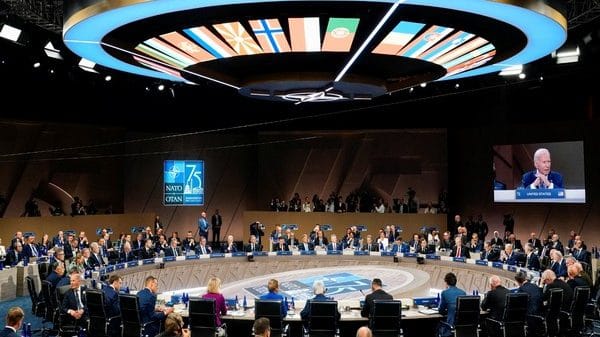Much like the octogenarian US President Joe Biden, NATO or the North Atlantic Treaty Organisation is facing a wobble. At the 75th anniversary summit in Washington this week, the 32 member nations coalesced around a single priority: Trump-proofing the organisation.
Rather than focusing on mutual defence or security, NATO today is primarily concerned with preventing the fracturing of the alliance should Donald Trump return to the US presidency later this year.
This focus would likely surprise NATO’s 12 founding members from 1949, when Harry S Truman declared that the countries were committing themselves to a “neighbourly act” for their “mutual protection.” However, it aligns perfectly with what the former bulwark against the Iron Curtain has become today: a bloc dominated by the US, with European neighbours depending on Washington for their protection.
This inflection point, with its misplaced priorities amid efforts to make NATO efficient again, is why the 75-year-old organisation is ThePrint’s Newsmaker of the Week.
NATO’s evolution
From 12 founding members, the collective defensive alliance now consists of 32 members, spanning from the Pacific Ocean in the West to the Baltic Sea in the East and the Black Sea in the South.
This expansion reflects the nature of the alliance, where the US, accounting for slightly more than a third of the total gross domestic product (GDP) among its allies, contributes about 61 per cent of the total military spending, according to a study by the Cato Institute. This indicates the outsized role the US plays within NATO and the associated challenges of the organisation.
The threat for the US in 2024, however, differs from that of 1949. As the embers of World War II slowly died down, Washington had a grand vision of aiding in the rebuilding of Europe through the Marshall Plan. NATO made sense at the time as a method to protect its investment against its biggest adversary, the USSR.
Today, the US’ biggest adversary, both economically and militarily, may no longer be Moscow, but Beijing. As the premier economic power, the US has spread itself thin across the globe, dealing with terrorism in West and Central Asia, competing against China, and protecting Europe against Russia.
Therein lies the crux of NATO’s identity crisis. European security is no longer the only threat for the US as geopolitics around the globe has evolved. It is now one of many security threats to Washington’s global power.
A failed project
In 1951, Dwight D Eisenhower, the first Supreme Allied Commander of Europe, reportedly remarked that US troops would have to leave the continent within 10 years, otherwise, the entire “project will have failed.”
Seven decades later, there are still close to 1,00,000 US troops on continental Europe. Russia’s special military operation in Ukraine showcased how ineffective the 32-member military alliance is in dealing with security threats without the aid of Washington.
If Eisenhower is to be believed, NATO in his eyes would be a failed project.
Take NATO support to Ukraine, for example:
– US contribution: €74 billion (including €50 billion in military aid)
– Total European allies’ contribution: €102 billion
– Germany (second-largest donor): €14.65 billion
– UK (third-largest donor): €12.6 billion
It took the war in Ukraine to see 23 NATO members reach the pledge of military spending — 2 per cent of total GDP — made in 2014. When Trump first assumed the presidency in 2017, only nine countries met this target.
In fact Canada, one of the founding members, only announced reaching the goal at the end of the summit this week. For a military alliance, the decision-making seems to be as slow as the negotiations for forming a federal government in Belgium.
This also brings us to the next problem: Donald Trump.
The Trump factor
At the recent summit, 32 countries gathered in Washington to prevent their alliance from being disturbed by one individual—not China’s Xi Jinping or Russia’s Vladimir Putin, but the former president of the host nation who may return to the White House.
A couple of hours after Biden welcomed the NATO leaders in his opening remarks, Trump, at a campaign rally in Florida, took aim at the organisation.
“I didn’t know what the hell NATO was too much before…But it didn’t take me long to figure it out, like about two minutes. And the first thing I figured out was they were not paying. We were paying, we were paying almost fully for NATO. And I said that’s unfair,” said the Republican presidential candidate, as reported by The New York Times.
From moving control of major elements of military aid from the US to NATO, to identifying a new Secretary General — Mark Rutte, former Prime Minister of the Netherlands fondly known as Teflon Mark for his ability to walk out of scandals unscathed and work with Trump – and even pushing up defence spending, the members of the alliance have focused on “Trump-proofing” themselves.
In the final Washington Summit Declaration, the gathered leaders agreed that Ukraine has an “irreversible” pathway to membership — especially given Trump’s fondness for Putin and Russia. This is a sign of how the alliance is trying to ensure any second-term for the ex-president would not have an easy way to renege on support to Kyiv.
However, Trump is a leader of a different calibre. In the past, he proudly told his supporters that he threatened European members with reneging on the mutual defence clause if they did not increase their military spending.
NATO’s current focus on protecting itself from potential US policy shifts under a second Trump presidency indicates how far the alliance has come from its original mission—and how far it has fallen since its victory in the Cold War.
(Edited by Prashant)






